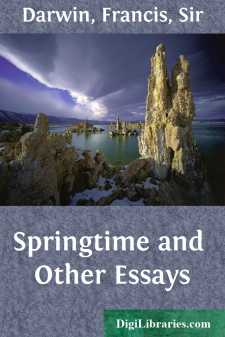Categories
- Antiques & Collectibles 13
- Architecture 36
- Art 48
- Bibles 22
- Biography & Autobiography 813
- Body, Mind & Spirit 142
- Business & Economics 28
- Children's Books 15
- Children's Fiction 12
- Computers 4
- Cooking 94
- Crafts & Hobbies 4
- Drama 346
- Education 46
- Family & Relationships 57
- Fiction 11828
- Games 19
- Gardening 17
- Health & Fitness 34
- History 1377
- House & Home 1
- Humor 147
- Juvenile Fiction 1873
- Juvenile Nonfiction 202
- Language Arts & Disciplines 88
- Law 16
- Literary Collections 686
- Literary Criticism 179
- Mathematics 13
- Medical 41
- Music 40
- Nature 179
- Non-Classifiable 1768
- Performing Arts 7
- Periodicals 1453
- Philosophy 64
- Photography 2
- Poetry 896
- Political Science 203
- Psychology 42
- Reference 154
- Religion 513
- Science 126
- Self-Help 84
- Social Science 81
- Sports & Recreation 34
- Study Aids 3
- Technology & Engineering 59
- Transportation 23
- Travel 463
- True Crime 29
Springtime and Other Essays
by: Francis Darwin
Description:
Excerpt
Governesses used to tell us that the seasons of the year each consist of three months, and of these March, April, and May make the springtime. I should like to break the symmetry, and give February to spring, which would then include February, March, April, and May. It has been said that winter is but autumn “shyly shaking hands with spring.” We will, accordingly, make winter a short link of two months—an autumnal and a vernal hand—December and January. It is a little sad for autumn to have to make room for chill November alongside of the happier months of September and October. But autumn is a season of decadence and cannot justly complain.
The autumnal flowers, which may be allowed to figure as a prelude to spring, are few in number. My favourite is lady’s tresses (Spiranthes), so called from the spiral twist in its inflorescence, which suggests braided hair. Gentiana amarella I should like to include, but its flowering-time is from 12th August to 8th September, and summer has the stronger claim on it. Other autumnal flowers are laurustinus and ivy. If we go by the mean date nothing flowers in October or November, and in December only the Christmas rose (Helleborus niger) is recorded by Blomefield.
But the autumn months have a glory of their own which may vie with the brightest hues of flowers. This great and beautiful panorama begins with the yellowing of the lime-leaves, which may occur as early as 17th August, but on the average is seen on 14th September. It is followed towards the end of September by a brown tint, showing itself in the leaves of the horse-chestnut. It is appropriate that these two species, which are not indigenous, should be the first to fade into glory. But I must not insist on the point, for we see wych-elm leaves fall 24th September, while the date for the common elm is 28th October; and the elm is a foreigner compared to the wych-elm, and retains a mark of its alien origin in not setting seeds.
The syringa (Philadelphus) is another foreigner, which early shows autumnal tints—yellowing on 27th September. Then follow some native trees: the beech and birch both turning yellow on 1st October, and being followed by the maple on 7th October. I like the motherliness of the half-grown beech, who refuses to drop her dead leaves in autumn, hoping (as I imagine) that they will shelter her tender leaves in the chilly springtime. The older beeches give up this anxious care, and doubtless laugh among themselves over the fussiness of young mothers. They forget, no doubt, that in the scrub at the feet of their own boles the habit persists.
With regard to the fall of leaves, the sycamore begins to lose them 2nd October; birch and cherry, 8th October; maple and walnut, 12th October; aspen, 13th October; beech and elder, 13th October; ash, 14th October; Lombardy poplar and Virginian creeper, 18th October; honeysuckle, 22nd October; hazel, 26th October; elm, 28th October; whitethorn, 30th October; plane, 3rd November. Judging by a single observation of Blomefield, the larch is the last performer in the drama of autumn. It turns yellow on 8th November, and its leaves fall 15th November.
Blomefield records that on 29th November the trees are “everywhere stript of leaves,” so that some sort of colour-drama has been in progress from the middle of September to the end of November. It may be objected that what has been said of autumn is but a catalogue of names and dates. And this is true enough; but when we realise the glory of autumnal decadence, it seems (however baldly recounted) to be a fitting prelude to the great outbreak of new life—green leaves and bright flowers that spring gives us....



